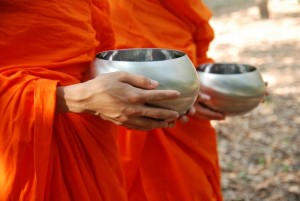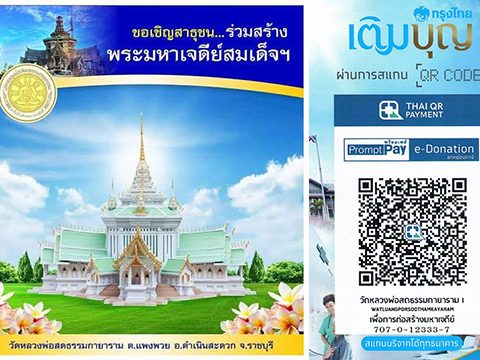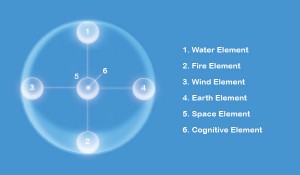

The temple and monastery of Wat Luang Phor Sodh Dhammakayaram in Thailand is a very busy place. During the rainy season the number of monks will reach almost a hundred. Nationwide the total number of monks is from the usual 100,000 to 200,000. This is all due to an old Thai tradition, many males (from the age of 20) will ordain for the three-month rainy season and most of them will then disrobe and return to lay life. This is possible, because Buddhist monks don’t take lifetime vows.
So like most monasteries in Thailand, this monastery has two main categories of monks: The short term monks who will ordain in order to make merits for their parents, especially for the mother who has no possibility to ordain herself, and then the long-term, dedicated monks, who might choose to spend their entire life wearing the orange robe. In both cases it is a unique opportunity for a man to spend time in solitude, studying the Buddhist teachings and meditating in order to purify the mind. The day he returns to lay life he will be well prepared to fill his future role as a good citizen.
Monks at this monastery come from all walks of life, the majority being younger men with good education and academic degrees. Some are scientists, doctors, engineers, businessmen, and pharmacists and they come from all parts of Thailand. The monk who was pharmacist in lay life now has his own clinic at the monastery helping fellow monks with medical problems, and the monk who was an engineer is the brain behind the buildings, bridges and monuments at the monastery.
The monks at Wat Luang Phor Sodh Dhammakayaram engage in various teaching activities. First and foremost, all monks and novices are required to study the national Dhamma studies syllabus and Pali language, to accompany the practice of meditation development. This Dhamma course is a comprehensive study, covering all the teachings found in the Tipika, the holy Buddhist scriptures. The Pali studies allow the scriptures to be approached in their original form, as well as helping to maintain the tradition of Buddhist monasticism in as pure a form as possible.
All this learning is then passed on in an abbreviated and practical form to the lay community in various ways. In this temple we have facilities to accommodate large groups of up to several hundred people, to come and practice and listen to lectures on the teachings. These groups are mostly school children who spend a few days, usually during the school holidays, at the temple. They are taught both individually and as a group, and are encouraged to follow and consider the monastic code of morality. Either the abbot or one of the senior monks will lead the daily Pujas and offer a lecture in the evening.
The monastery has also ordained several foreigners over the years, men from USA, Japan, Malaysia, China, Russia, Britain and Denmark. At the moment the temple has two American monks, one has been a monk here for eight years and spends most days of the year teaching meditation to the English speaking visitors who come to visit the Wat and he also assists the Venerable Abbot to teach Dhamma in English once a month via National Thai Radio.
Like other temples, Wat Luang Phor Sodh Dhammakayaram has a number of novices. They are young boys from the age of 10 up to 19. When they reach 20 they can ordain as monks. The code of discipline for novices is not as rigid as that for the monks. A monk observes 227 precepts while novices only have 10 precepts to follow. Like the monks they study Buddhist scriptures, the ancient language, Pali, meditate, and even do a fair amount of physical work.
Requesting Ordination

Ordination can be requested as either a novice or a monk, but a candidate must be able to speak and understand basic Thai in order to be accepted. All candidates are required to undertake the 8 precepts, practice Buddhism and meditation for 1 or 2 weeks in order to be qualified to be ordained based on the monastery rules [there are monks who train all international candidates in preparation for ordination].
According to the Rules laid down by Lord Buddha, some may not become monks:
- One who has murdered an Arahant (Enlightened One),
- One who has murdered his mother or father,
- One who has injured the Lord Buddha,
- One who has caused a schism in the Sangha,
- One who has pretended to be a monk without ordination,
- One who has left the Sangha and ordained in another religion,
- One who was a monk and committed any of the four ‘disrobing offences’ (parajika),
- One who is a Eunuch or Hermaphrodite.
Qualifications to ordain as a monk and a novice
- The candidate must be 20 years of age or more, counting from when “consciousness first appeared in his mother’s womb”. If, by mistake, he was ‘ordained’ under the age of 20, the candidate remains a ten precept novice and is not a monk,
- The candidate must a Buddhist to be qualified for ordination,
- The candidate must have permission of both parents, or guardians if parents are deceased,
- No smoking or drinking any kind of alcohol,
- No certain diseases such as HIV or other serious diseases [All applicants are required to have medical check, it costs about 500-1000 Bath or $20 and is included in the application fee].
- There are others still who should not be ordained, although if they are ordained by mistake their ordination is valid. These include: one with infectious diseases, a slave, one escaped from jail, one known to be wanted by the police, one with unpaid debts, one in the ‘King’s Service’ (e.g. a soldier), one maimed, deformed, disabled or very old (meaning to the extent that it is impractical to perform the duties of monastic life). One also needs the permission of one’s parents. Also, one may not be ordained without a set of robes and a bowl of one’s own.
An applicant needs to bring:
- Two 2 inch-Photos without glasses
- A government issued ID card, passport or drivers license.
- 12,000 Baht for ordination procedure, not including the cost of medical check.
Note: An application form is available at the temple.










 ไลน์ "@wlps" เพื่อรับข่าวสารจากทางวัด
ไลน์ "@wlps" เพื่อรับข่าวสารจากทางวัด
